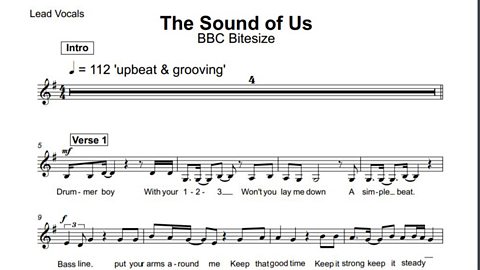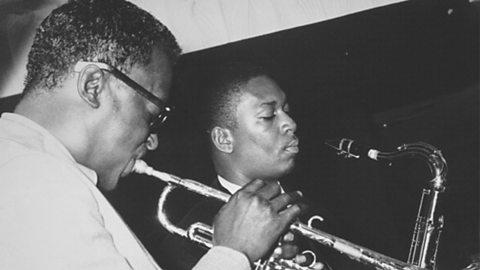- Learn about how lyrics are written for songs.
- Find out more about lyrics by Billie Eilish, The Noisettes and Dave.
- Follow steps to write your own lyrics for a melody.
Watch how Tara and Ben get started with writing lyrics for their song.
Ben: How are the lyrics coming along?
Tara: Iām a bit stuck. I took the title of the song that we decided on, 'The Sound of Us', and I ran with it. Iām trying to use words associated with music and sound, so I started by introducing all of the instruments that we play in the first verse.
Ben: I like the idea. What have you got so far?
Tara: Well, for the opening Iāve gotā¦ Drummer boy, count us in with your one, two, three. You start playing nowā¦ And then Iām stuck.
Ben: One, two, three. What kind of rhymes with three? Tree, freeā¦
Tara: You start playing now. Come set us free. That doesnāt quite work.
UKULELE PLAYING
Ben: You start playing nowā¦ A simple beatā¦
Tara: Thatās it. Doesnāt quite rhyme with three, but works really well. Drummer boy, count us in with your one, two, three. You start playing now a simple beatā¦ I think thereās too many words for the melody at the start. Lets try and simplify it?
UKULELE PLAYING
Ben: Drummer boy with your one, two, threeā¦
Tara: Won't you lay me down a simple beat.
Ben: Thatās awesome.
Tara: Iām struggling with the next bit though. I donāt think thereās enough.
UKULELE PLAYING
Tara: Bass line, put your arms around me, keep that good time, keep it strong, keep it steadyā¦
Ben: The words are great. Why donāt you try lengthening them over the notes in the melody, like- Bass li-ineā¦ And then at the end, you could do- Ste-ady.
UKULELE PLAYING
Tara: Bass li-ine, put your arms around me, keep that good time. Keep it strong, keep it ste-adyā¦
Ben: Sounds good. Letās try one line after the other.
UKULELE PLAYING
Drummer boy with your one, two, threeā¦
There are no rules when it comes to writing lyrics. Some lyrics rhyme and some donāt. Some tell a story, whereas others focus on a single emotion or message.
Some artists compose lyrics by taking inspiration from the world around them. Some will use famous pieces of literature, like poems, to inspire them.
Some people will write lyrics first and then make a melody to fit, whereas others will start with a melody and write words to match the tune.
Depending on the approach, here are two key tips for lyric writing:
- Focus on one single idea ā try not to over complicate what you are trying to express.
- Use repetition ā repeated words or phrases will help lyrics stick in the minds of your listeners.
Listen to these examples of lyrics
Listen to You Should See Me in a Crown by Billie Eilish. The lyrics for this song were inspired by Moriarty in the “óĻó“«Ć½ series Sherlock. Eilish has said that her songs are often inspired by ābad guyā characters.
Listen to Atticus by The Noisettes. Harper Leeās book To Kill a Mockingbird provided the inspiration and the first line of the song. The title comes from one of the main characters.
Listen to Black by Dave. His words on race and culture sparked debate when it was played on “óĻó“«Ć½ Radio 1 shows. His album won a Brit award in 2020.
Where to start
Choose a subject
You can draw on your own personal experience, the experiences of others or something new. Anything that inspires you can be the source of lyrics - it could be a book you have read, or a film you have seen.

Capture your ideas
Inspiration can strike at any moment. Many musicians and writers carry a notebook with them or use a notes app on their phones in order to jot down ideas on the go.
You could also record yourself with a voice memos app, speaking or singing when you get ideas for lyrics.
Types of lyrics
Some lyrics tell a story - either real or imagined. Some focus on a single emotion, such as love or loss. Some lyrics challenge people to think - they might make a political point, or question how people think and behave.
Write a hook
A hook could be a line in a song that gets stuck in people's heads. It might be the title of the song, the first line or a line that is repeated in a chorus. It needs to be repeated in order to be remembered.
A couple of good examples are We Will Rock You by Queen, or Single Ladies (Put a Ring on it) by BeyoncƩ. Both of these songs contain repeated lyrics that make the song memorable.
Verses and choruses
Most pop songs are made up of verses and choruses.
Each verse will often have the same melody, but different lyrics each time.
The chorus will often have the same melody and words each time it is repeated.

Have a go
Writing lyrics is a very personal thing, and different approaches work for different people. When starting to write lyrics, try these steps as starting points to inspire your own writing:
- Choose a subject and create a thought-cloud ā a mind map of words, memories or images related to that subject. Try to create rhyming lines from the words on your thought-cloud.
- Find a story online or in a newspaper or magazine that interests you. Try to turn the story into a series of lyrics, with four lines for each verse. To keep it simple, remove the unnecessary details and try to capture the most important parts of the story.
Remember that writing lyrics is a skill that you can improve through regular practice. Set yourself some basic targets, like writing four lines a day for a week, to get yourself into the habit of writing.
Explore the score
In the film above, Tara and Ben are working together to write the lyrics for their song.
Download the sheet music to see how the final song comes together.
Download the sheet music for the band's song The Sound Of Us.

Download the lead vocal sheet music of The Sound Of Us.

Listen to more
Listen to the bandās live performance of the song.
Focus on the vocal line and the lyrics.
and try singing along.
Listen to the band perform their song The Sound Of Us.
Quiz
Keywords
| Keyword | Definition |
|---|---|
| melody | A sequence of notes that form the tune in a piece of music. |
| verse | A section of a song that contains the same melody, but different lyrics each time it is repeated. |
| chorus | A section of a song that contains the same melody and lyrics each time it is repeated. |
| hook | A memorable lyric in a song, usually repeated. |
Play Bitesize secondary games. game
Have fun playing science, maths, history, geography and language games.

More on Composing music
Find out more by working through a topic
- count3 of 8

- count4 of 8

- count5 of 8

- count6 of 8
